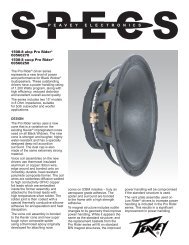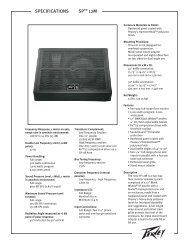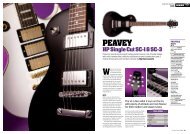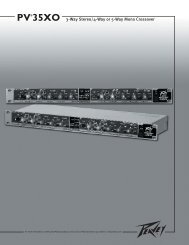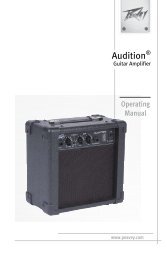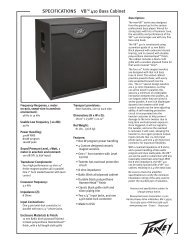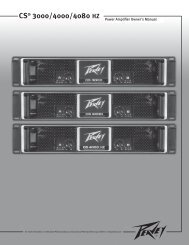UL Super Subs.indd - Peavey
UL Super Subs.indd - Peavey
UL Super Subs.indd - Peavey
Create successful ePaper yourself
Turn your PDF publications into a flip-book with our unique Google optimized e-Paper software.
Messenger Series<strong>UL</strong>-118S & 215SLow Frequency EnclosuresOPERATING INSTRUCTIONSEnceintes Basses FréquencesGUIDE D’UTILISATIONTieffrequenz BoxenBEDIENUNGSANLEITUNGCajas de Baja FrecuenciaINSTRUCCIONES DE USO
<strong>UL</strong>-118S & <strong>UL</strong>-215SCaja de Baja FrecuenciaIntroducciónGracias por elegir la caja de baja frecuencia de <strong>Peavey</strong> <strong>UL</strong>118S ó 215S, como parte de su sistema de sonorización. Estamosorgullos del diseño y manufactura de nuestras unidades, de las que esperamos la máxima seguridad y funcionamiento.Su altavoz <strong>UL</strong> ha sido rigurosamente testado antes de ser enviado a su distribuidor.ImpedanciaEl <strong>UL</strong>118S ó 215S tiene un impedancia nominal de 4 ohms.FiltroLa práctica de la biamplificación permite el pleno control de los componentes usados en el <strong>UL</strong>118S ó 215S. No se ha fijado elfiltro pasivo interno para conseguir un mejor funcionamiento. Se requiere, por tanto, de un filtro activo o electrónico tál como elVSX o el XD 2/3/4, con una frecuencia entre 100 y 250Hz. Recomendamos los modulos <strong>Peavey</strong> PL-100, PL-150 o PL-250cuando utilice etapas de potencia de la serie CS® con crossover aislados.Facilidades de SatéliteHemos equipado su altavoz de baja frecuencia <strong>UL</strong>118S ó 215S con un adaptador satélite pole.Usando el adaptador correcto,no incluído, simplemente instale el satélite sobre su <strong>UL</strong>118S ó 215S. Los satélites <strong>Peavey</strong> recomendados son el <strong>UL</strong>-10,<strong>UL</strong>-12 o el <strong>UL</strong>-15 ( en 4 ó 8 ohms).Cualquier distribuidor autorizado de <strong>Peavey</strong> puede suministrarle los adaptadores.Ref.<strong>Peavey</strong> # 15900380.Conexión en Modo Bi-AmpConecte la salida de baja frecuencia del amplificador de potencia a la entrada de su <strong>UL</strong>118S ó 215S utilizando un cableNeutrik con clavija 1+ y 1-. Configure el <strong>UL</strong>-10, <strong>UL</strong>-12 o el <strong>UL</strong>-15 en el modo de Full Range o pasivo (ver guía deinstrucciones). Use un cable Neutrik clavijas 1+ y 1- para conectar desde la salida de alta frecuencia del amplificador a laentrada del <strong>UL</strong>-10, <strong>UL</strong>-12 o el <strong>UL</strong>-15.ES<strong>UL</strong>-15 utilizando un Neutrik, clavija 1+ y 1-. Conecte el paso mediano a la entrada de <strong>UL</strong>-10, <strong>UL</strong>-12 o <strong>UL</strong>-15 usandoConexión en Modo Tri-AmpPara conseguir la máxima funcionalidad, el altavoz de baja frecuencia <strong>UL</strong>118S ó el 215S puede ser triamplificado con los<strong>UL</strong>-10, <strong>UL</strong>-12 o <strong>UL</strong>-15. Configure los altavoces <strong>UL</strong>-10, <strong>UL</strong>-12 o <strong>UL</strong>-15 en modo bi-amp. Ahora necesitará dosfiltros. Para la caja de baja frecuencia seleccione entre 100 y 250 Hz y para <strong>UL</strong>-10, <strong>UL</strong>-12 o el <strong>UL</strong>-15 1200 Hz (conmotor EQ). Simplemente conecte el paso de baja frecuencia a la entrada de baja frecuencia de la caja <strong>UL</strong>-10, <strong>UL</strong>-12 oclavija Neutrik 1+ y 1-. Finalmente , conecte la salida de alta frecuencia a la entrada del <strong>UL</strong>-10, <strong>UL</strong>-12 o <strong>UL</strong>-15 usandoclavijas Neutrik 2+ y 2-.Cableado de AltavocesSu Messenger <strong>UL</strong> tiene entradas Speakon Neutrik. Es importante utilizar un cable doble conductor de medida adecuada, cuyareferencia <strong>Peavey</strong> es #00712570#, 4 pole Neutrik no está incluido.¡AVISO! LOS CABLES DE ALTAVOCES PUEDEN GENERAR DESCARGAS ELÉCTRICAS. TENGA CUIDADOESPECIALMENTE CON LAS TERMINACIONES. PEAVEY RECOMIENDA QUE APAGUE LA ETAPA DEPOTENCIA MIENTRAS CONECTA O DESCONECTA UN ALTAVOZ.¡AVISO! ESTA CAJA NO HA SIDO DISEÑADA PARA SER SUSPENDIDA DE NINGUNA MANERA. NO INTENTESUSPENDERLA UTILIZANDO LAS ASAS U OTRO MEDIO.PRECAUCIÓN ! ESTE ALTAVOZ PUEDE PRODUCIR ALTOS NIVELES DE SONIDO. USELO CON EXTREMOCUIDADO CUANDO LO CONECTE A LA MAXIMA POTENCIA.CONS<strong>UL</strong>TE A SU DISTRIBUIDOR AUTORIZADO DE PEAVEY ANTE CUALQUIER DUDANeutrik y Speakon son marcas registradas de NEUTRIK A.G.Debido a nuestra política de continuo desarrollo de nuestros productos, las características y especificaciones indicadas están sujetas a cambiossin noticiación previa.
<strong>UL</strong>-118S & 215SLow Frequency EnclosuresIntroductionThank you for choosing <strong>Peavey</strong>’s <strong>UL</strong>118S or 215S low frequency speaker enclosure as part of your sound reinforcementsystem. We take great pride in the design and manufacture of our units and you can expect top performance and reliability. YourMessenger <strong>UL</strong> enclosure has been rigorously tested before packing and despatch to your dealer.ImpedanceThe impedance of the <strong>UL</strong>118S and 215S is 4 ohms.CrossoverThe practice of bi-amplification allows full control over the performance of the drivers used in the <strong>UL</strong>118S and 215S. Foroptimum performance, no internal passive crossover is fitted to the <strong>UL</strong>118S or 215S. An electronic crossover such as theVSX or XD2/3/4 will be required with a crossover point of between 100 and 250Hz. We recommend <strong>Peavey</strong>’s PL-100, PL-150 or PL-250 modules when using the CS® series of power amplifiers fitted with crossover islands.Satellite pole facilityWe have equipped the <strong>UL</strong>118S and 215S low frequency enclosure with a satellite-pole facility. By using the correct satellitepole (not supplied) simply mount your satellite onto the <strong>UL</strong>118S or 215S. Suitable satellites are <strong>Peavey</strong>’s <strong>UL</strong>-10, <strong>UL</strong>-12or the <strong>UL</strong>-15 ( in 4 or 8 ohms). Stand poles (PEAVEY PART # 15900380) are available from your <strong>Peavey</strong> dealer.Connection in bi-amp modeFrom the power amplifier low pass output connect to the input of the <strong>UL</strong>118S or 215S using Neutrik pins 1+ and 1-. Configurethe <strong>UL</strong>-10, <strong>UL</strong>-12 or <strong>UL</strong>-15 in full range mode (see relevant operating guide). From the amplifier hi pass output connectto the <strong>UL</strong>-10, <strong>UL</strong>-12 or <strong>UL</strong>-15 input using Neutrik pins 1+ and 1-.UKConnection in tri-amp modeFor maximum performance, the <strong>UL</strong>118S and 215S low frequency enclosure can be tri-amped with the <strong>UL</strong>-10, <strong>UL</strong>-12or <strong>UL</strong>-15. Configure the <strong>UL</strong>-10, <strong>UL</strong>-12 or <strong>UL</strong>-15 to its bi-amp mode (refer to the relevant operating guide). Twocrossover points are now required. For the low frequency enclosure, select between 100 and 250Hz and for the <strong>UL</strong>-10, <strong>UL</strong>-12 or the <strong>UL</strong>-15, 1200Hz (with compression driver EQ). Simply connect the low pass to the input of the low frequencyenclosure using Neutrik pins 1+ and 1-. Connect the mid pass to the input of the <strong>UL</strong>-10, <strong>UL</strong>-12 or <strong>UL</strong>-15 using Neutrikpins 1+ and 1-. Finally, connect the hi pass to the input of the <strong>UL</strong>-10, <strong>UL</strong>-12 or <strong>UL</strong>-15 using Neutrik pins 2+ and 2-.Speakon Cable WiringYour Messenger <strong>UL</strong> enclosure is fitted with low loss Neutrik input sockets, either of which must be wired to a regular twinconductor cable (PEAVEY PART # 00712570) using a 4-pole Neutrik plug (not supplied).DANGER! LOUDSPEAKER CABLES CAN CARRY HAZARDOUS VOLTAGES. TAKE CARE IN TERMINATINGYOUR CABLES. PEAVEY STRONGLY RECOMMEND THAT THE POWER AMPLIFIER IS SWITCHED OFFWHILST CONNECTING OR DISCONNECTING EITHER END OF THE LOUDSPEAKER CABLE.DANGER! THIS ENCLOSURE HAS NOT BEEN DESIGNED TO BE FLOWN IN ANY WAY. NEVER ATTEMPT TOSUSPEND USING THE HANDLES OR BY ANY OTHER MEANS.CAUTION ! THIS SPEAKER IS CAPABLE OF HIGH SOUND PRESSURE LEVELS. USE EXTREME CARE INSETTING MAXIMUM LOUDNESS.CAUTION! DO NOT USE ANY SATELLITE POLE OTHER THAN THE PS-B.IN CASE OF DIFFIC<strong>UL</strong>TY CONS<strong>UL</strong>T YOUR AUTHORISED PEAVEY DEALERNeutrik and Speakon are registered trademarks of NEUTRIK A.G.Due to our policy of continuing development, features and specifications are subject to change without notice.
<strong>UL</strong>-118S & <strong>UL</strong>-215SEnceintes basses fréquencesIntroductionNous vous remercions d’avoir choisi l’enceinte basses fréquences <strong>UL</strong>118S ou 215S. Nous sommes très fiers de la conceptionet de la réalisation de ces enceintes d’un excellent rendement et d’une grande fiabilité. Votre enceinte Messenger <strong>UL</strong> a étésoumise à des essais rigoureux avant d’être conditionnée et expédiée à votre revendeur.ImpédanceL’impédance des enceintes <strong>UL</strong>118S ou 215S est de 4 OhmsFiltreLa pratique de la biamplification permet de profiter pleinement des performances des enceintes basses fréquences Messenger<strong>UL</strong>s. Pour un rendement optimum, les enceintes <strong>UL</strong>118S ou 215S ne possèdent pas de filtre passif interne. Un filtre actif telle VSX ou le XD 2/3/4 est nécessaire, avec une fréquence de coupure située entre 100 et 250Hz. Nous recommandons lesmodules PL-100,PL-150 ou PL-250 <strong>Peavey</strong> pour une utilisation avec les amplificateurs de puissance de la série CS®, munis defiltres modulaires.Equipement pour Enceintes SatellitesNous avons équipé les enceintes basses fréquences <strong>UL</strong>118S ou 215S d’un adaptateur pour stand, situé sur la face supérieure.En utilisant la perche adéquate, placez simplement votre enceinte satellite (telles les <strong>UL</strong>-10, <strong>UL</strong>-12 ou <strong>UL</strong>-15) sur les<strong>UL</strong>118S ou 215S. Des perches pour satellites (PS-B, <strong>Peavey</strong> part nº15900380) sont en vente chez votre revendeur <strong>Peavey</strong>.Connections en BiamplificationConnectez la sortie basses fréquences de votre amplificateur de puissance à l’entrée de l’enceinte <strong>UL</strong>118S ou 215S en utilisantles pins Neutrik 1+ et 1-. Configurez les enceintes <strong>UL</strong>-10, <strong>UL</strong>-12 ou <strong>UL</strong>-15 en mode plein registre (voir les noticesd’utilisation correspondantes). Connectez la sortie hautes fréquences de votre amplificateur de puissance aux entrées des <strong>UL</strong>-10, <strong>UL</strong>-12 ou <strong>UL</strong>-15 en utilisant les pins Neutrik 1+ et 1-.FRConnectez simplement le passe-bas à l’entrée de l’enceinte basses fréquences en utilisant les pins Neutrik 1+ et 1-. ConnectezConnections en TriamplificationPour un rendement maximum, les enceintes basses fréquences Messenger <strong>UL</strong> peuvent être utilisées dans un système detriamplification. Configurez les enceintes <strong>UL</strong>-10, <strong>UL</strong>-12 ou <strong>UL</strong>-15 en mode bi-amp (voir les notices d’utilisationcorrespondantes). Deux fréquences de coupures sont ici nécessaires. Pour les enceintes basses fréquences, choisissez unefréquence de coupures entre 100 et 250Hz et pour les <strong>UL</strong>-10, <strong>UL</strong>-12 ou <strong>UL</strong>-15, située à 1200Hz (avec EQ CDH).le passe-bande à l’entrée des HiSys <strong>UL</strong>-10, <strong>UL</strong>-12 ou <strong>UL</strong>-15, en utilisant les pins Neutrik 1+ et 1-. Enfin, connectez lepasse-haut à l’entrée des <strong>UL</strong>-10, <strong>UL</strong>-12 ou <strong>UL</strong>-15, en utilisant les pins Neutrik 2+ et 2-.Câbles et Prises SpeakonVotre enceinte Messenger <strong>UL</strong> dispose de fiches Neutrik à faibles pertes devant être connectées à un câble standard (nonfourni, <strong>Peavey</strong> ref 00712570) composé de deux conducteurs de calibre suffisant et disposant de prises Neutrik à 4 pôles.DANGER! LES CABLES DE HAUT-PARLEURS PEUVENT PRESENTER DES TENSIONS IMPORTANTES.PRENEZ SOIN DE LA REALISATION DE VOS CABLES. AFIN D’EVITER TOUT RISQUE D’ELECTROCUTION,PEAVEY RECOMMANDE LA MISE HORS TENSION DE L’AMPLIFICATEUR DE PUISSANCE LORS DUBRANCHEMENT DES CABLES.DANGER! CETTE ENCEINTE N’A PAS ETE CONCUE POUR ETRE SUSPENDUE. NE JAMAIS SUSPENDRE PARLES POIGNEES OU PAR TOUT AUTRE MOYEN.ATTENTION! CE SYSTÈME DE HAUT-PARLEURS PEUT PRODUIRE UNE PRESSION ACCOUSTIQUEIMPORTANTE. PRENEZ TOUTES LES PRECAUTIONS NECESSAIRES LORS D’UNE UTILISATION A FORTEPUISSANCE.ATTENTION! UTILISEZ UNIQUEMENT LA PERCHE PS-B AVEC CETTE ENCEINTE.En cas de difficultés, consultez votre revendeur <strong>Peavey</strong>.Neutrik et Speakon sont des marques déposées par NEUTRIK A.G.Etant donnée notre politique de développement continu, les caractéristiques et spécifications sont sujettes à des modifications sans préavis.
<strong>UL</strong>-118S & <strong>UL</strong>-215STieffrequenz BoxVielen Dank, daß Sie sich für den Erwerb unserer <strong>Peavey</strong> <strong>UL</strong>118S oder 215S Tieffrequenz Lautsprecherbox entschiedenhaben. Unsere Messenger <strong>UL</strong> Lautsprechersysteme werden nach den gegenwärtig modernsten Kenntnissen designed undentwickelt, erwarten Sie daher Top-Performance und hohe Zuverlässigkeit. Ihr Lautsprecher wurde eingehend geprüft, bevor eran Ihren Händler verschickt wurde.ImpedanzDie <strong>UL</strong>118S oder 215S hat eine Impedanz von 4 Ohm.FrequenzweicheMit dem Bi-Ampbetrieb, auch Aktivbetrieb genannt, hat man eine bessere Kontrolle über die Performance der einzelnenLautsprecherchassis, die in der <strong>UL</strong>118S oder 215S verwendet werden. Deshalb ist keine passive Frequenzweiche eingebaut.Sie benötigen eine Frequenzweichenplatine oder ein Modul wie z.B. das VSX oder XD2/3/4 mit einer Trennfrequenzzwischen 100 Hz und 250 Hz. Wenn Sie Ihre Lautsprecherbox mit der <strong>Peavey</strong> CS®-Verstärker-Serie mit eingebauterFrequenzweichenplatine benutzen, empfehlen wir die <strong>Peavey</strong> PL-100, PL-150 oder PL-250 Module.DistanzstangenWir haben Ihre <strong>UL</strong>118S oder 215S Tieffrequenz-Lautsprecherbox mit einem eingebauten Ständer-Flansch ausgestattet. Bittebenutzen Sie die richtigen Distanzstangen, um Ihren Sattelit auf die <strong>UL</strong>118S oder 215S aufzustecken. (Distanzstangen werdennicht mitgliefert). Passende Topteile (Satteliten) sind hier <strong>UL</strong>-10, <strong>UL</strong>-12 oder <strong>UL</strong>-15 ( in 4 oder 8 Ohm). Die Stangen(PS-B, Artikel-Nr.: 15900380) erhalten Sie bei jedem <strong>Peavey</strong>-Händler.Betrieb in Bi-AmpmodeVerbinden Sie den Tiefpass Ausgang Ihres Verstärkers mit dem Eingang Ihrer <strong>UL</strong>118S oder 215S und benutzen Sie dafürPins 1+ und 1- für die Belegung Ihres Neutrik-Steckers. Stellen Sie die <strong>UL</strong>-10, <strong>UL</strong>-12 oder <strong>UL</strong>-15 auf Full-Range Mode(siehe Bedienungsanleitung). Schließen Sie den Hochpass Ausgang Ihres Verstärkers an den Eingang der <strong>UL</strong>-10, <strong>UL</strong>-12oder <strong>UL</strong>-15 an, indem Sie Neutrik Pins 1+ und 1- benutzen.DE100 Hz und 250 Hz und für die <strong>UL</strong>-10, <strong>UL</strong>-12 oder <strong>UL</strong>-15, 1200 Hz (mit 22 RX Kompressionstreiber EQ). SchließenVerbindung in Tri-AmpmodeFür eine maximale Performance der <strong>UL</strong>118S oder 215S Tieffrequenzboxen, können diese mit den <strong>UL</strong>-10, <strong>UL</strong>-12 oder<strong>UL</strong>-15 im Tri-Ampmode betrieben werden. Konfigurieren Sie dazu die <strong>UL</strong>-10, <strong>UL</strong>-12 oder <strong>UL</strong>-15 auf Bi-Ampmodus(siehe entsprechende Bedienungsanleitung). Sie brauchen hierzu zwei Trennfrequenzen. Wählen Sie für die Tieftonbox zwischenSie nun einfach den Tiefpass-Endstufenausgang an den Eingang Ihrer Bassbox an, indem Sie Neutrik Pins 1+ und 1- benutzen.Schließen Sie den Bandpass-Endstufenausgang an den Eingang der <strong>UL</strong>-10, <strong>UL</strong>-12 oder <strong>UL</strong>-15 an, unter Nutzung vonNeutrik Pins 1+ und 1-. Zuletzt schließen Sie den Hochpass- Endstufenausgang an den Eingang der <strong>UL</strong>-10, <strong>UL</strong>-12 oder<strong>UL</strong>-15 unter Benutzung von Neutrik Pins 2+ und 2- an.Speakon KabelverbindungIhr Messenger <strong>UL</strong> Lautsprecher ist mit einer verlustarmen Neutrik Eingangsbuchse ausgestattet, die an ein 2-poligesLautsprecherkabel mit entsprechendem Leiterquerschnitt und einen 4-poligen Neutrik-Speakonstecker angeschlossen wird.(Speakonstecker nicht im Lieferumfang enthalten) Sie können diesen als Option mit der Artikelnummer 00712570 erhalten.ACHTUNG! GEFAHR! LAUTSPRECHERKABEL KÖNNNEN EXTREM STARKE SPANNUNG FÜHHREN. BITTEACHTEN SIE DARAUF, DASS SIE ZUERST DEN VERSTÄRRKER ABSCHALTEN, BEVOR SIE DIE KABEL AUSDEN LAUTSPRECHERANSCHLÜSSSEN ZIEHEN.GEFAHR! DIESE BOXENSERIE IST AUSSCHLIESSLICH FÜRR DEN GEBRAUCH AM BODEN UND/ODERMIT ENTSPRECHEND STABILEN STATIVEN KONZIPIERT. DAHER IST DIESE SERIE NICHT FÜRR EINEFLUGMONTAGE GEEIGNET.ACHTUNG! DIESE LAUTSPRECHERSERIE IST IN DER LAGE SIGNALE MIT SEHR HOHEM SCHALLDRUCKZU PRODUZIEREN, DAHER GEHEN SIE BITTE SORGSAM MIT DER EINSTELLUNG DER MAXIMALENLAUTSTÄRRKE UM.Sollten Sie dennoch Schwierigkeiten haben, so fragen Sie bitte Ihren autorisierten <strong>Peavey</strong>-Händler.Neutrik und Speakon sind eingetragene Markenzeichen der NEUTRIK AG.Aufgrund der stänndigen Weiterentwicklung unserer Produkte behalten wir uns eine Änderung der Spezifikationen sowie der einzelnenBestandteile vor.




